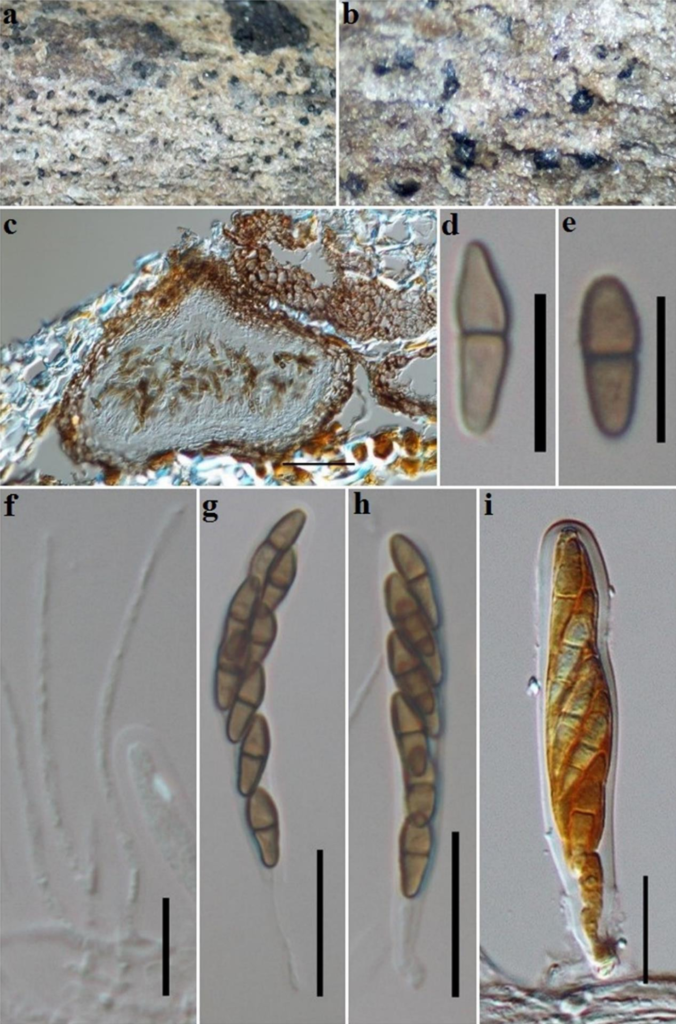Fungalpedia – Note 89 Palmiascoma
Palmiascoma Phook. & K.D. Hyde
Citation when using this entry: Pem et al., in prep – Genera of Dothideomycetes Mycosphere.
Index Fungorum, Facesoffungi, MycoBank, GenBank, Fig. 1
Palmiascoma is a monotypic genus described by Phookamsak & K.D. Hyde (Liu et al. 2015) with P. gregariascomum as the type species. Palmiascoma are basically saprobic and grow on bamboo culms. The genus has corticolous, coriaceous, gregarious uni- or multi-loculate perithecia, which are scattered, immersed to erumpent, ostiolar necks are papillate, and the peridium is composed of textura subglobosa and textura angularis cell layers. Asci are bitunicate with long pedicels. Ascospores are brown, didymosporous, apical cells are wider and more acute than basal cells. The anamorphs of Palmiascoma produce pycnidial conidiomata that contain one-celled conidia on artificial agar media. The present collection has small differences with type species (Liu et al. 2015) in having slightly larger ascomata (140–203 × 148–213 µm vs. 130–180 × 130–250 μm), asci ((46) 48 – 62 (67) × 7 – 9.5 vs (45–)50–60(–67) × 7–10 μm) and ascospores (10.5–14 × 5.5 vs. 11–13 × 3–4 μm). Although the genus Palmiascoma was introduced based on its occurrence on palm hosts, its host range is extended from palm fronds (Arecaceae) to decaying twigs of Morinda citrifolia (Rubiaceae). Palmiascoma belongs to the family Bambusicolaceae as a single complex formed in multigene phylogeny, but is distinct morphologically having brown spores rather than hyaline, fusiform spores that are found in Bambusicola (Liu et al. 2015; Dai et al. 2017). Currently Palmiascoma has sequence data for ITS, LSU and SSU regions. Palmiascoma also shares similarities in morphological characters with genera such as Didymosphaeria and Verruculina in having brown didymosporous ascospores (Zhang et al. 2012) but is distinct in phylogeny. In the present study, the specimen has been collected from India, thus expanding its geographical range in Asia (India and Thailand).
Figure 1 – Palmiascoma gregariascomum (India, Andaman and Nicobar Islands, South Andaman, Dollygunj NIOT campus (11˚64’51.4” N 92˚70’37.4” E PUFNI 17630). a, b Ascomata. c Vertical section of ascoma. d, e Ascospores. f Pseudoparaphyses. g-i Asci. Scale bars: c = 50 µm, g–i = 20 µm, d-f = 10 µm.
References
Dai DQ, Phookamsak R, Wijayawardene NN, Li WJ et al. 2017 – Bambusicolous fungi. Fungal Diversity 82, 1–105.
Liu JK, Hyde KD, Jones EG, Ariyawansa HA et al. 2015 – Fungal diversity notes 1–110, taxonomic and phylogenetic contributions to fungal species. Fungal diversity 72, 1–97.
Zhang Y, Crous PW, Schoch CL, Hyde KD. 2012 – Pleosporales. Fungal diversity 53, 1–221.
Entry by
Niranjan M & Sarma VV, Center of Excellence in Fungal Research and School of Science, Mae Fah Luang University, Chiang Rai, 57100, Thailand and Department of Biotechnology, Pondicherry University, Kalapet, Puducherry – 605014, India
(Edited by Kevin D. Hyde)
